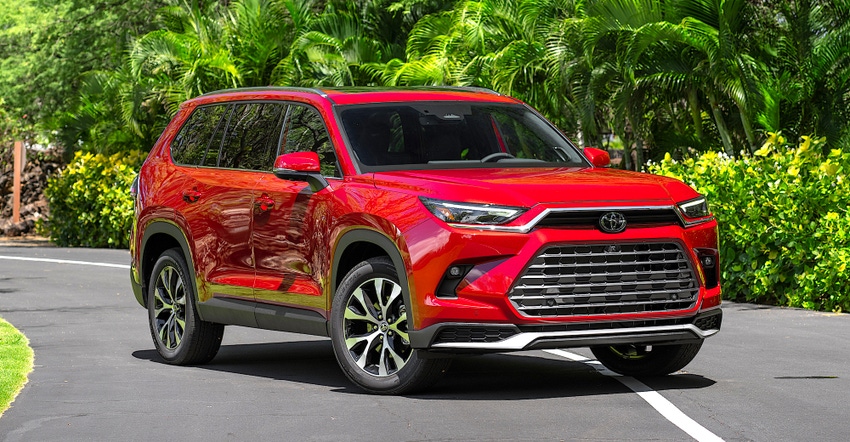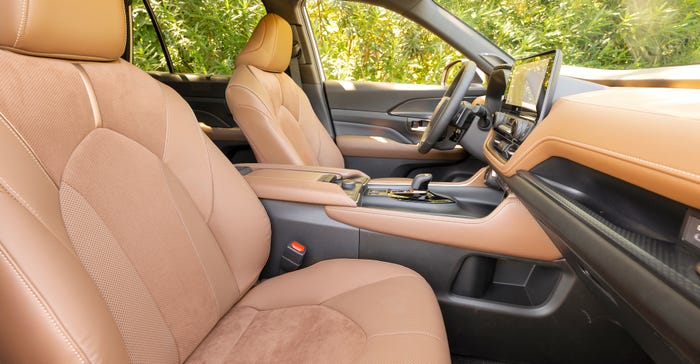Does this longer, three-row version of the Highlander crossover SUV have what it takes to challenge the best?

While Toyota already has a large three-row SUV, the massive Sequoia is a heavy, thirsty, hard-to-park beast that is comparable to the likes of the Chevrolet Tahoe or Ford Expedition, so introducing a stretched three-row version of the front-drive, unibody Highlander to compete with rivals like the Honda Pilot and Kia Telluride fills an obvious hole in the company’s lineup.
The company has made an effort to differentiate between the original two-row Highlander and this more spacious Grand Highlander, providing the newcomer with unique exterior styling to help set it apart rather than simply elongating the existing Highlander’s bodywork. The slightly more aggressive styling should play well for customers seeking to avoid the soccer mommy stereotype, even if the front end does skew in the direction of the permanently scowling Evil Emperor Zurg from Toy Story!
Grand Highlander also gets three different powertrains, front-wheel drive and all-wheel drive, and three different trim levels, with base pricing that ranges from $44,405 (including destination charges) to $59,460. The three drivetrains are a base turbocharged combustion-only engine, a hybrid-electric, and a higher-performance hybrid-electric. That base engine is a 265-horsepower, 310-lb.-ft. turbocharged 2.4-liter I-4 engine connected to an eight-speed automatic transmission. The efficiency-minded hybrid uses a naturally aspirated 2.5-liter Atkinson cycle I-4 and an electric motor built into a continuously variable transmission (CVT) in traditional Prius hybrid fashion for a total system power rating of 245 hp.
The Hybrid Max employs a turbocharged 2.4-liter I-4 like the one in the gas model, combined with an electric motor rated at a combined 362 hp. and driving through a six-speed planetary automatic transmission. Both hybrids employ traditional nickel metal hydride battery packs. The regular hybrid’s has 1.3 kilowatt-hours of capacity and the Hybrid Max’s is 1.44 kWh.
The gas model’s EPA combined fuel economy rating is 24 mpg, compared to an impressive 34 mpg for the hybrid, and 27 mpg for the Hybrid Max. During my lengthy rural highway drive in the hybrid at modest speeds around 55 mph, I saw 35 mpg, which is in line with the predicted 32 mpg highway for my tested XLE AWD model. In shorter, harder-driving stints in the gas and Hybrid Max models, they predictably fell short of expectations due to the driving conditions.
However, what was discernable in those short bursts is that while the Hybrid Max is impressively quick (Toyota estimates its 0-60 mph acceleration is 6.3 seconds, the gas model feels sluggish, even compared to the regular hybrid. Toyota says the gas version is quicker at 7.5 seconds 0-60, compared to 7.8 seconds for the hybrid, so maybe it is a trick of the electrically assisted power delivery and the hybrid’s CVT, but the gas definitely feels slower. Toyota said it expects that about two-thirds of Grand Highlander buyers will choose the gas engine, about one-third will choose the hybrid, and the Hybrid Max will slice about 6 percent of sales from the shares of the other two.
The Grand Highlander rolls on a wheelbase that stretches four more inches between the axles to open up more space in the rear and it reaches a total of 5.5 inches longer. It is also 2.3 inches wider. It is available in six, seven, or eight-seat configurations, and even with the extra width, the idea of three-abreast seating in the Grand Highlander seems optimistic. Kids small enough to realistically be comfortable sitting three across in this vehicle will need to be in child safety seats or boosters, which will not fit three across.
Adults won’t be excited about the three-across accommodations, but if it is just a matter of a cramped trip from the airport for out-of-town visitors, Grand Highlander will be fine. It fits seven roll-aboard-sized suitcases in the cargo area behind the third seat! For frequent or long-distance space for more than six, drop the vanity steering you away from the Sienna (or rival brand) minivan and make the rational choice.
The third-row seat does provide acceptable adult legroom and headroom, though in the typical fashion, the floor is kind of high so occupants lack thigh support for long-term adult-size comfort. The real issue with the third row is ingress and egress. Toyota has designed the second-row seat to move conveniently out of the way, but it is still a chore to climb back there or to extract yourself, so maybe consider it suitable for young adults at best.

On the road, the Grand Highlander is pleasant and comfortable in the Toyota tradition, and it even handles twisty parts of the road with better-than-expected poise and control, though that would naturally be diminished with a full load of passengers who don’t want to be made motion sick anyway.
All the expected amenities are there, plus features such as seven USB-C charging ports and an available pair of 120-volt AC power outlets for connecting household devices. The Platinum version has a facial recognition system that, when the driver opts in, automatically configures the vehicle’s settings to that driver’s preferences. Amid current concerns about the safety of AI, this sounds like an opportunity for 2001: A Space Odyssey’s HAL 9000 to decline your request to open the pod bay door!
But as many as five other people aboard the Grand Highlander will surely be comfortable and satisfied with their spots inside Toyota’s new three-row family machine.
About the Author(s)
You May Also Like





